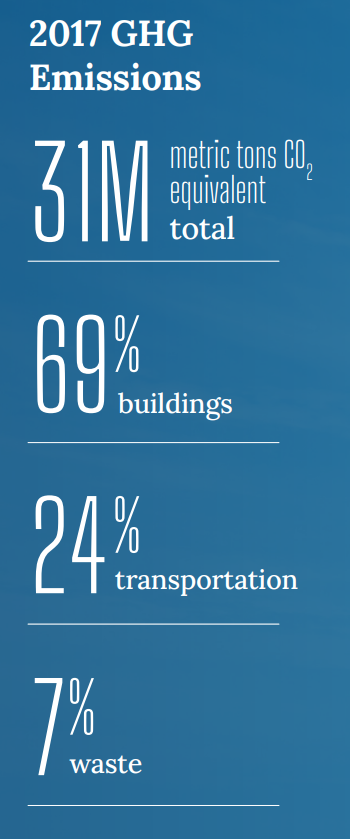Electrify Chicago
According to the
2022 Chicago Climate Action Plan,
a whopping 69% of Chicago's emissions come from buildings, making it
our biggest challenge and our biggest opportunity as a city to tackle
change. At Electrify Chicago we want to showcase some of the best and worst performing
buildings in the city using publicly available data and manual annotations to add
building photographs and label multi-building owners like universities.
You can start by looking at Chicago's buildings with the highest greenhouse gas intensity - this means that they use the most energy when adjusted per unit of square foot, so big buildings could actually perform much better than very inefficient small buildings on this metric.
Legislative update! 🎉
As of late January 2024, legislation is being introduced to require new buildings use more efficient forms of water and space heating, via the Clean And Affordable Buildings Ordinance (CABO), which will reduce the number of highly polluting and inefficient that end up on this site.
If you're in Chicago,
write to your alderman to support the CABO!
Chicago Buildings by Greenhouse Gas Intensity
Note: Data only includes large Chicago buildings from 2021, unless explicitly stated otherwise.
Note: This data only includes buildings whose emissions are reported
under the
Chicago Energy Benchmarking Ordinance. According to the City “As of 2016,
this list includes all commercial, institutional, and residential buildings larger than
50,000 square feet.” This dataset is also then filtered to only buildings with
reported emissions > 1,000 metric tons CO2 equivalent.
This data is also from 2021, but when new benchmark data is available, we'll update the site.
| Property Name / address | Primary Property Type |
Greenhouse Gas Intensity (kg CO2 eq./sqft) |
Total Greenhouse Emissions (metric tons CO2 eq.) |
|---|---|---|---|
|
Bauer Building
230 W Huron St
| Office | 6.0 kg/sqft
Lowest 41%
| 397 tons
Lowest 18%
|
|
5630 N Sheridan
5630 N Sheridan Ave
| Multifamily Housing | 6.0 kg/sqft
Lowest 41%
| 1,433 tons
Highest 33%
|
|
Grace St.
635 W Grace St
| Multifamily Housing | 6.0 kg/sqft
Lowest 41%
| 757 tons
Lowest 44%
|
|
900 North Franklin
900 N Franklin St
| Office | 6.0 kg/sqft
Lowest 41%
| 580 tons
Lowest 33%
|
|
Edgebrook Elementary School
(CPS)
6525 N Hiawatha Ave
| K-12 School | 6.0 kg/sqft
Lowest 41%
| 392 tons
Lowest 17%
|
|
Chicago Bulls College Prep
(CPS)
2040 W Adams St
| K-12 School | 6.0 kg/sqft
Lowest 41%
| 693 tons
Lowest 41%
|
|
Roald Amundsen High School
(CPS)
5110 N Damen Ave
| K-12 School | 6.0 kg/sqft
Lowest 41%
| 1,317 tons
Highest 35%
|
|
Luther Burbank Elementary School
(CPS)
2035 N Mobile Ave
| K-12 School | 6.0 kg/sqft
Lowest 41%
| 1,000 tons
Highest 45%
|
|
James Shields Middle School
(CPS)
2611 W 48th St
| K-12 School | 6.0 kg/sqft
Lowest 41%
| 573 tons
Lowest 33%
|
|
LaSalle II Magnet Elementary School
(CPS)
1148 N Honore St
| K-12 School | 6.0 kg/sqft
Lowest 41%
| 554 tons
Lowest 31%
|
|
Ferdinand Peck Elementary School
(CPS)
3826 W 58th St
| K-12 School | 6.0 kg/sqft
Lowest 41%
| 663 tons
Lowest 39%
|
|
Carl von Linne Elementary School
(CPS)
3221 N Sacramento Ave
| K-12 School | 6.0 kg/sqft
Lowest 41%
| 641 tons
Lowest 38%
|
|
University Hall
2345 N Clifton Ave
| College/University | 6.0 kg/sqft
Lowest 41%
| 519 tons
Lowest 28%
|
|
4950 Powhatan Building Corp.
4950 S Chicago Beach Dr
| Multifamily Housing | 6.0 kg/sqft
Lowest 41%
| 1,013 tons
Highest 44%
|
|
210 East Pearson Condominium Association
210 E Pearson
| Multifamily Housing | 6.0 kg/sqft
Lowest 41%
| 628 tons
Lowest 37%
|
Data Source:
Chicago Energy Benchmarking Data
